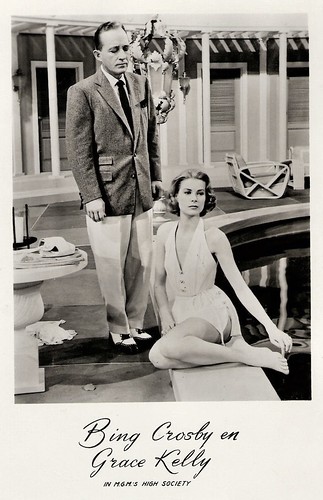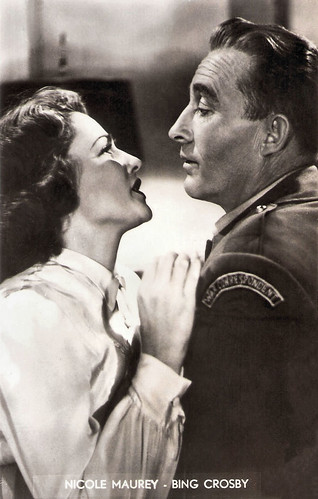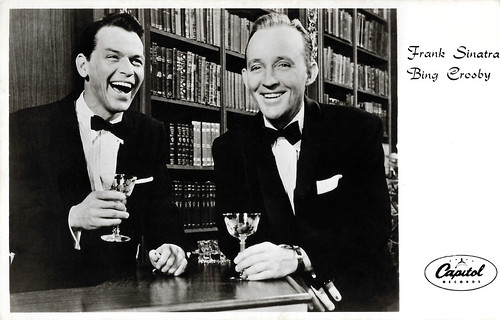
Uruguayan postcard by CF. Photo: Paramount.

British postcard, sent by mail in 1935. Photo: Paramount Pictures.

British postcard by Art Photo, no. 169. Mary Carlisle and Bing Crosby in Doctor Rhythm (Frank Tuttle, 1938).

Dutch postcard by Takken, no. 3015. Photo: MGM. Bing Crosby and Grace Kelly in High Society (Charles Walters, 1956).

American Candid Color Card, Beverley Hills, Calif., no. A 39. Photo: Bud Fraker / Paramount. Caption: Bing Crosby, Paramount's great star, and husband of Dixie Crosby, and their four sons: Gary Evan, born June 25, 1933; twins Phillip Land and Dennis Michael, born July 13, 1934, and Lindsay Harry, born Jan. 5, 1938.
White Christmas
Bing Crosby was born Harry Lillis Crosby, Jr. in Tacoma, Washington, in 1903. He was the fourth of seven children of Catherine Helen "Kate" (Harrigan) and Harry Lowe Crosby, a brewery bookkeeper.
Crosby studied law at Gonzaga University in Spokane but was more interested in playing the drums and singing with a local band. Bing and the band's piano player, Al Rinker, left Spokane for Los Angeles in 1925.
In the early 1930s, Bing's brother Everett sent a record of Bing singing 'I Surrender, Dear' to the president of CBS. His live performances from New York were carried over the national radio network for 20 consecutive weeks in 1932.
His radio success led Paramount Pictures to include him in the musical comedy The Big Broadcast (Frank Tuttle, 1932), a film featuring radio favourites. His songs about not needing a bundle of money to make life happy had the right message for the decade of the Great Depression. He was the star of such radio shows as 'Kraft Music Hall' (1935-1946), 'Philco Radio Time' (1946-1949), 'The Bing Crosby Chesterfield Show' (1949-1952), and 'The Bing Crosby Show' (1954-1956).
His song 'White Christmas' became the bestselling single for more than 50 years until overtaken in 1997 by 'Candle in the Wind', Elton John's tribute to the late Princess Diana.

American postcard by Brunswick. Photo: Paramount.

Dutch postcard, no. 599, sent by mail in 1934. Photo: Metro-Goldwyn-Mayer. Marion Davies and Bing Crosby in Going Hollywood (Raoul Walsh, 1933).

British card. Photo: Paramount. Bing Crosby as J. Paul Jones in Here Is My Heart (Frank Tuttle, 1934).

British postcard in the Picturegoer Series, London, no. 768. Photo: Paramount.

Dutch chewing card by Smith's Chewing Sweets Ltd., Rotterdam, no. 7 for 48. This card is a gift from Loek Coenraad from his mother's legacy.
Road to...
Bing Crosby's relaxed, low-key style carried over into the series of 'Road to...' comedies he made with pal Bob Hope and Dorothy Lamour. The series consists of Road to Singapore (Victor Schertzinger, 1940), Road to Zanzibar (Victor Schertzinger, 1941), Road to Morocco (David Butler, 1942), Road to Utopia (Hal Walker, 1946), Road to Rio (Norman Z. McLeod, 1947), Road to Bali (Hal Walker, 1952), and The Road to Hong Kong (Norman Panama, 1962).
He won the Best Actor Oscar for playing the easygoing priest Father Chuck O'Malley in Going My Way (Leo McCarey, 1944), and was nominated for his reprise of the role in The Bells of St. Mary's (Leo McCarey, 1945) opposite Ingrid Bergman the next year, becoming the first of six actors to be nominated twice for playing the same character.
He showed that he was indeed an actor as well as a performer when he played an alcoholic actor down on his luck opposite Grace Kelly in The Country Girl (George Seaton, 1954). Stagecoach (Gordon Douglas, 1966) with Ann-Margret, was his last major film. Though it did not get good reviews, his performance as the drunken doctor was praised.
Playing golf was what he liked to do best. Bing Crosby died at age 74 playing golf at a course outside Madrid, Spain, after completing a tour of England that had included a sold-out engagement at the London Palladium. On 13 October 1977, the day before Crosby's death, independent producer Lew Grade announced that he was reuniting Crosby, Bob Hope, and Dorothy Lamour onscreen for the film Road to the Fountain of Youth, ending several years of speculation as to whether the trio would reunite professionally or not.
Bing Crosby was married twice: first, he married film actress Dixie Lee. They had four children and divorced in 1952. He married his second wife, Kathryn Grant, in 1957. They had three children and remained together till his death in 1977. His eldest son Gary Crosby criticised Bing's violent ways as a father in the biography 'Going My Own Way' (1983) which was touted as a "Daddy Dearest". Bing's children from his second marriage, including daughter and actress Mary Crosby, praised him as a kind and loving father in later life. Phil Crosby, Jr., Bing's grandson, formed a jazz quartet in the Los Angeles area and is bringing a semi-resurgence of interest in Bing and his music.

Belgian postcard, no. 850. Photo: Paramount Pictures.

Dutch postcard, no. 249. Photo: Paramount Pictures / M.P.E.A. Bing Crosby, Bob Hope and Dorothy Lamour in Road to Morocco (David Butler, 1942).

Dutch postcard by J.S.A., no. 740 / 101. Photo: Paramount Pictures.

Vintage postcard. Photo: Paramount. Nicole Maurey and Bing Crosby in Little Boy Lost (George Seaton, 1953).

Dutch postcard by Editions Altona, Amsterdam / Gebr. Spanjersberg, Rotterdam, no. 5135. Photo: Capitol Records. Frank Sinatra and Bing Crosby in High Society (Charles Walters, 1956).

French postcard, by Editions P.I., offered by Les Carbones Korès "Carboplane", no. 792. Photo: Paramount Pictures, 1954.
Sources: Dale O' Connor (IMDb), Wikipedia, and IMDb.
No comments:
Post a Comment